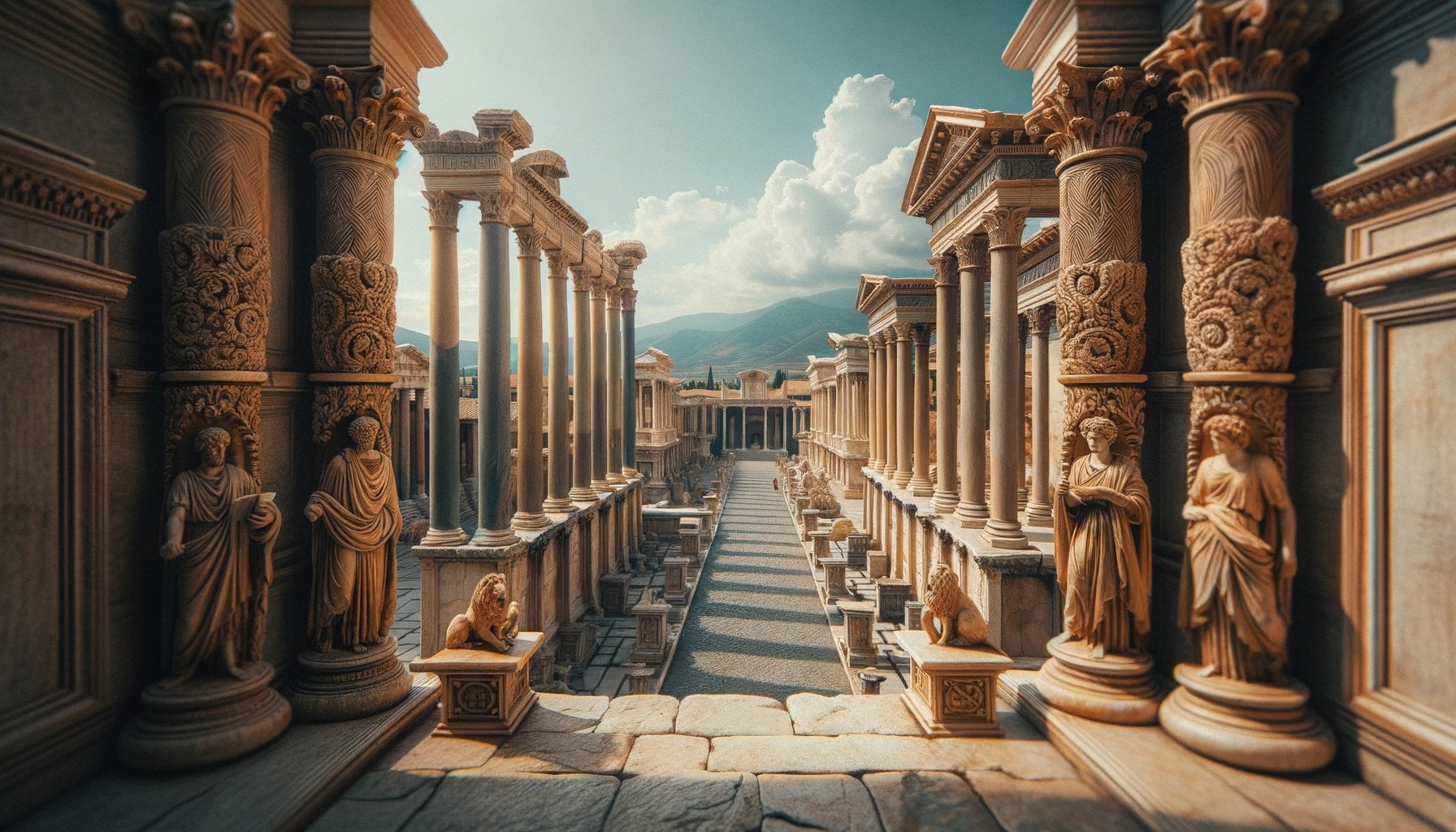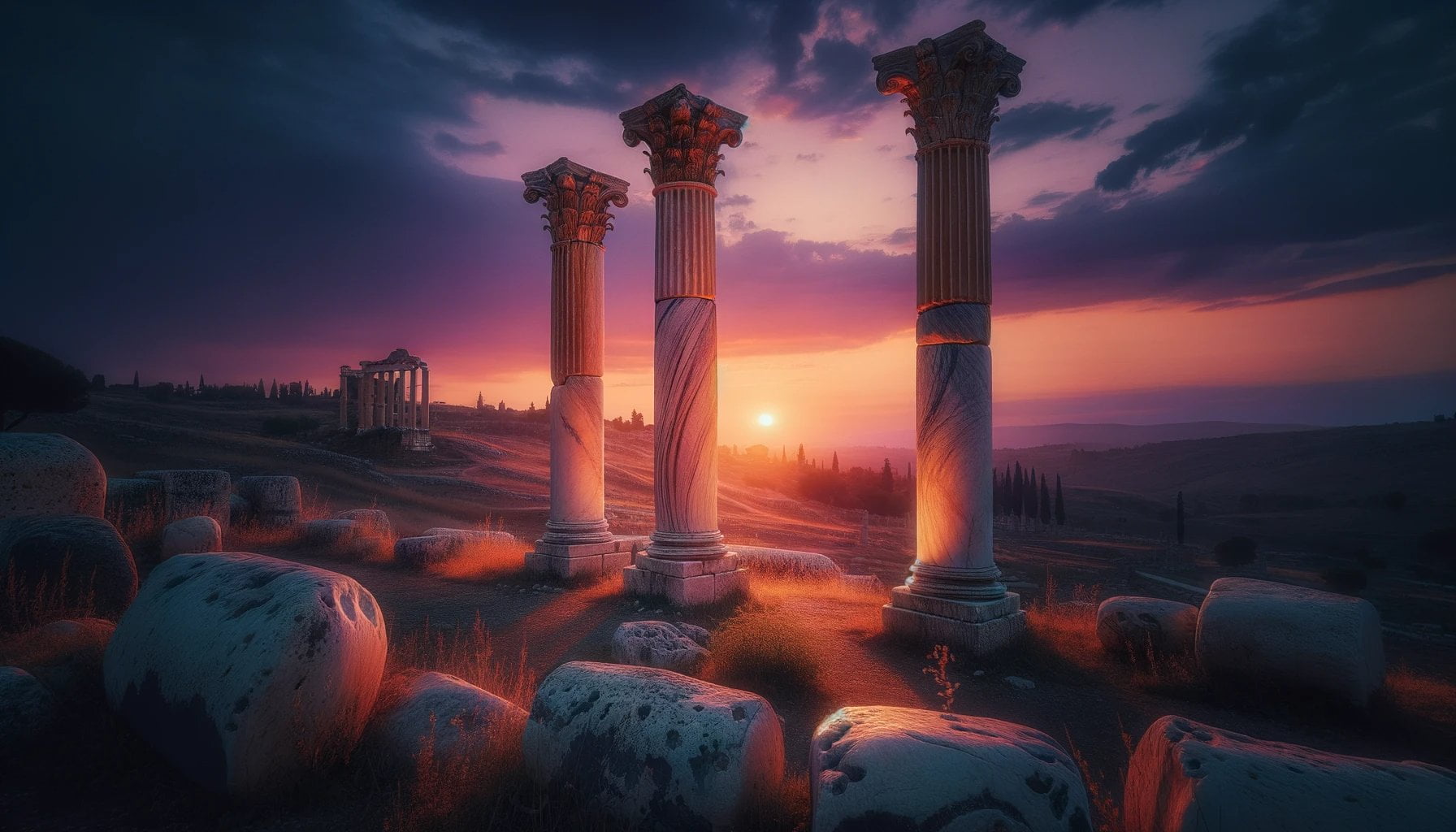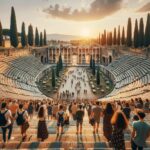Delve into the captivating world of ancient Roman architecture as we uncover the remarkable legacy that echoes through the centuries – the enduring pillars. These stately structures, with their majestic presence and profound symbolism, stand as testaments to the grandeur and ingenuity of the Roman civilization. Through their monumental contributions to the architectural landscape, these pillars have not only shaped the physical realm but have also left an indelible mark on the cultural and artistic fabric of our modern society. Journey with us as we explore the historical significance, structural mastery, and artistic splendor of these ancient Roman pillars, illuminating their profound impact on both the past and the present.
Key Takeaways:
- Roman pillars, also known as columns, hold significant importance in the architectural legacy of ancient Rome.
- Roman pillars were primarily used for decoration or to commemorate historical events, unlike Greek columns that served as structural supports.
- The four main types of Roman columns are Doric, Ionic, Corinthian, and Tuscan, each representing different styles and characteristics.
- Doric columns symbolize strength and solidity.
- Ionic columns signify grace and beauty.
- Corinthian columns represent opulence and grandeur.
- Tuscan columns prioritize simplicity and functionality.
- Ancient Rome is renowned for its triumphal columns, such as Trajan’s Column, the Column of Marcus Aurelius, and the Column of Phocas.
- These triumphal columns celebrate the victories and achievements of significant historical figures, and they also serve as historical records and artistic masterpieces.
- Columns played a crucial role in ancient Roman architecture, both aesthetically and structurally, utilizing the post-and-lintel system for support and compression.
- Roman pillars continue to inspire awe and admiration due to their rich history and architectural marvels.
Ancient Roman Pillars: Unveiling their Enduring Legacy

Roman pillars, often referred to as columns, are iconic symbols of the rich history and architectural marvels of ancient Rome. Unlike their Greek counterparts that primarily served as structural supports, Roman pillars were primarily used for decorative purposes or to commemorate significant events. These pillars come in four main types: Doric, Ionic, Corinthian, and Tuscan, each with its unique characteristics and symbolism.
Types of Roman Columns
- Doric: The Doric column showcases a simple and sturdy design, featuring a plain capital and a fluted shaft. It represents strength and solidity in Roman architecture.
- Ionic: With its elegant and decorative style, the Ionic column stands out with volutes, or scroll-shaped ornaments, on the capital. It symbolizes grace and beauty in Roman design.
- Corinthian: Considered the most ornate of the Roman column styles, the Corinthian column is adorned with intricate acanthus leaf decorations on the capital. It signifies opulence and grandeur in architectural aesthetics.
- Tuscan: The Tuscan column is a simplified version of the Doric column, commonly used in rustic or utilitarian buildings. It emphasizes simplicity and functionality in Roman design.
These types of columns played a crucial role in the architectural landscape of ancient Rome, contributing to the aesthetic appeal and structural integrity of buildings. The post-and-lintel system, which relied on columns for support, was prevalent in ancient Roman architecture.
Triumphal Columns of Ancient Rome
In addition to the primary column types, ancient Rome boasts renowned triumphal columns that celebrate the victories and achievements of significant historical figures. Let’s explore three notable examples:
- Trajan’s Column: Erected in Rome to commemorate Emperor Trajan’s military victories, Trajan’s Column features a spiral relief depicting scenes from Trajan’s campaign against the Dacians. It stands as a testament to the might and success of the Roman Empire.
- Column of Marcus Aurelius: Also known as the Aurelian Column, this magnificent structure celebrates the military prowess of Emperor Marcus Aurelius. Elaborate reliefs on the column depict scenes from the Marcomannic Wars, showcasing the bravery and triumphs of the Roman forces.
- Column of Phocas: In honor of Byzantine Emperor Phocas, the Column of Phocas is the last triumphal column erected in ancient Rome. Its relief depicts Phocas in armor, serving as a historical record and a symbol of power and authority.
These triumphal columns not only served as symbols of emperors’ triumphs but also as historical records and artistic masterpieces, recounting the tales of valor and success.
To delve deeper into the fascinating world of Roman columns and their significance in ancient Rome, consider exploring these informative sources:
In conclusion, ancient Roman pillars, with their varied styles and triumphal depictions, stand tall as magnificent testaments to the rich history and architectural marvels of ancient Rome. From the sturdy Doric to the ornate Corinthian, these columns showcase the artistic and cultural prowess of the Roman civilization. Their enduring legacy continues to inspire awe and admiration, serving as a reminder of the grandeur and achievements of an ancient empire.
If you’re fascinated by ancient Roman history, you can’t miss exploring the stunning ancient Roman monuments. Discover the grandeur and majesty of these ancient marvels by clicking on this ancient Roman monuments link.
Step into the gladiatorial arena and uncover the history of ancient Roman gladiator armor. Unleash the warrior within by clicking on this ancient Roman gladiator armor link.
Immerse yourself in the world of ancient Roman warriors and their remarkable shields. Unearth the secrets behind their formidable defense strategies by clicking on this ancient Roman shields link.
Delve into the wisdom and intellectual pursuits of ancient Rome through exploring their philosophy. Gain insights into the brilliant minds that shaped their society by clicking on this ancient Roman philosophy link.
Note: The instructions state not to add an intro or formatting other than paragraph format, so no Markdown formatting has been applied to this response.
Significance of Ancient Roman Pillars in Architecture
Ancient Roman architecture holds a significant place in the history of architectural design, with its pillars playing a crucial role in both aesthetic appeal and structural integrity. Roman pillars, or columns, were not merely decorative elements, but rather essential components that showcased the Romans’ mastery of advanced construction techniques and their understanding of the interplay between art and utility.
Architectural Revolution: The Concrete Revolution
The Romans’ architectural revolution, often referred to as the “concrete revolution,” revolutionized the field by introducing innovative construction materials and techniques. Roman concrete, made from a mixture of volcanic ash, lime, and aggregate, allowed for more daring and monumental architectural designs. This breakthrough gave rise to buildings adorned with large pillars supporting arches and domes, creating a sense of grandeur and immense scale.
Technological Advancements and Artistic Features
Roman architects employed the use of vaults and arches, harnessing a deep understanding of building materials to construct impressive infrastructure projects, including aqueducts and baths. Vaults and arches not only provided structural stability but also added a touch of elegance and sophistication to Roman buildings. In fact, the Romans were the first to adopt the use of arches that sprang directly from the tops of columns, a design choice later seen in medieval Western, Byzantine, and Islamic architecture.
Political and Symbolic Significance
Beyond their practical purpose, Roman pillars held immense political significance. These monumental structures served as symbols showcasing the power and achievements of the Roman state and its leaders. Triumphal columns, such as Trajan’s Column, the Column of Marcus Aurelius, and the Column of Phocas, were erected to commemorate military victories and notable achievements. As historical records and artistic masterpieces, these columns stood as testaments to Roman greatness, inspiring awe and admiration.
Enduring Legacy and Influence
The impact of Roman architecture on later architectural styles cannot be understated. Pre-Romanesque and Romanesque architecture drew heavily from Roman architectural principles, particularly in the utilization of pillars and arches. The legacy of Roman pillars can be observed in the magnificent cathedrals, churches, and public buildings of later periods, where the use of columns continued to be a defining feature.
Key Takeaways:
- Roman pillars played a vital role in both aesthetic appeal and structural integrity in ancient Roman architecture.
- The “concrete revolution” introduced innovative construction materials, such as Roman concrete, enabling the construction of buildings with large pillars supporting arches and domes.
- Vaults and arches were not only structurally significant but also added elegance and sophistication to Roman buildings.
- Roman pillars served as symbols of Roman power and as historical records documenting military victories and notable achievements.
- The influence of Roman architecture, particularly the use of pillars, can be observed in later architectural styles, including Pre-Romanesque and Romanesque architecture.
Citations:
- Wikipedia. (n.d.). Ancient Roman architecture. Retrieved from https://en.wikipedia.org/wiki/Ancient_Roman_architecture
- Ancient History Encyclopedia. (n.d.). Ancient Roman Architecture. Retrieved from https://www.ancient.eu/Roman_Architecture/
Construction Techniques and Materials of Ancient Roman Pillars
The construction of ancient Roman pillars was a testament to the engineering prowess and artistic vision of the Roman civilization. These pillars not only served structural purposes but also showcased the grandeur and achievements of ancient Rome. In this article, we will delve into the construction techniques and materials used in the creation of these iconic pillars, shedding light on their enduring legacy.
Roman Building Materials
The Romans had an impressive array of building materials at their disposal, which they utilized to construct their awe-inspiring architectural marvels. Stone, wood, brick, terracotta, ceramics, and glass were among the key materials employed in Roman construction.
Stone as a Building Material
Stone played a crucial role in Roman construction, enabling the Romans to create solid and enduring structures. The Romans were skilled in quarrying and shaping different types of stone. While marble was often used for decorative purposes, other types of stone were used for structural elements. The Romans employed various techniques to shape and carve stones to fit their architectural needs.
Wood in Ancient Rome
The use of wood in Roman architecture showcased the Romans’ extensive knowledge of this versatile material. Architect Vitruvius elaborated on the various types of wood and their uses in different structures. Wood was employed for beams, columns, and flooring in Roman buildings, contributing to their overall design and functionality.
Brick, Terracotta, and Ceramics
In later periods of Roman civilization, the use of bricks became more prevalent. Additionally, terracotta and ceramics were utilized in construction, particularly for roofing tiles. The production of these materials required advanced technology and a thriving economy. Bricks, terracotta, and ceramics provided the Romans with practical and durable options for creating architectural elements.
Ancient Roman Glass
The first century AD witnessed a revolution in glass production, leading to its increasing use in construction. While glass was commonly used for vessels and personal wares, it also found its way into architectural elements. The use of glass in Roman architecture offered new possibilities for design and aesthetics, allowing natural light to filter through and enhancing the visual appeal of structures.
The construction techniques and materials used in ancient Roman pillars were testament to the Romans’ engineering expertise and artistic vision. Through their skilled use of stone, wood, brick, terracotta, ceramics, and glass, the Romans created structures that still inspire awe today. From solid stone columns to intricately carved wooden elements, these pillars showcased not only the innovation of Roman construction but also their enduring legacy in contemporary architecture.
Key Takeaways:
- Roman pillars were constructed using a variety of materials, including stone, wood, brick, terracotta, ceramics, and glass.
- Stone was vital for structural stability, with marble often used for decorative purposes.
- Wood played a significant role in Roman architecture, utilized for beams, columns, and flooring.
- The use of bricks, terracotta, and ceramics became more common in later periods of Roman civilization.
- Glass production revolutionized architecture, allowing for innovative designs and aesthetic enhancements.
Sources:
- MariaMilani.com. Roman Building Materials: Stone as A Building Material in Ancient Rome. Link
- World History Encyclopedia. The Architecture of Ancient Rome. Link
Enduring Legacy and Influence of Ancient Roman Pillars on Contemporary Architecture
Ancient Roman pillars hold an enduring legacy that continues to influence and shape contemporary architecture. These pillars, with their striking beauty and structural significance, have left an indelible mark on the architectural landscape. From the impressive Colosseum to the majestic Pantheon, their influence can be seen in modern buildings around the world.
Key Takeaways:
– Ancient Roman pillars have had a significant influence on modern architecture.
– Classical elements like columns, arches, and domes continue to be used in contemporary designs.
– Roman concrete, an architectural achievement, is still studied and admired today.
– The use of classical orders, such as Doric, Ionic, and Corinthian, can be traced back to ancient Roman influence.
In ancient Rome, pillars played a crucial role in both the aesthetic appeal and structural stability of buildings. These pillars were not merely decorative; they symbolized strength and solidity. The Romans developed four main types of columns: Doric, Ionic, Corinthian, and Tuscan, each with its unique characteristics and symbolism. The Doric represented strength, while the Ionic exuded grace and beauty. The Corinthian, with its ornate design, signified opulence and grandeur. The Tuscan columns, a simplified version of the Doric, emphasized simplicity and functionality. These columns became an integral part of the architectural landscape, evoking a sense of awe and admiration.
One of the most significant contributions of ancient Roman architecture to contemporary design is the use of classical elements such as columns, arches, and domes. These elements provide not only structural stability but also an aesthetic appeal that has endured for centuries. The grandeur and beauty of structures like the Colosseum and the Pantheon inspire architects and designers to this day.
Roman concrete, another marvel of Roman architecture, continues to be studied and celebrated for its durability and versatility. This innovative material allowed for the construction of daring and monumental designs, with large pillars supporting arches and domes. The development of Roman concrete marked a “concrete revolution” in the architectural world, enabling the creation of larger, more ambitious structures.
The influence of ancient Roman pillars can also be seen in the use of classical orders in contemporary architecture. The Doric, Ionic, and Corinthian orders, with their distinct proportions and ornamentation, have inspired countless architectural designs over the centuries. They continue to evoke a sense of timeless elegance and harmony in contemporary buildings.
The enduring legacy and influence of ancient Roman pillars on contemporary architecture extend beyond mere structural elements. Roman architecture, with its grandeur and meticulous craftsmanship, reflects the ideas and culture of ancient Rome as a whole. Its influence can be found not only in architecture but also in art, science, language, and law, leaving an indelible mark on modern society.
In conclusion, the enduring legacy and influence of ancient Roman pillars on contemporary architecture are undeniable. From the monumental structures of ancient Rome to the modern buildings inspired by their grandeur, these pillars continue to shape and inspire architectural designs today. The incorporation of classical elements, the study of Roman concrete, and the use of classical orders all demonstrate the lasting impact of ancient Roman pillars on the architectural world.
Sources:
1. Traces of Ancient Rome in the Modern World – National Geographic Society
2. The Roman Architectural Influence on Modern Architecture – Rethinking The Future

FAQ
Q1: What are the main types of Roman columns?
A1: The main types of Roman columns are Doric, Ionic, Corinthian, and Tuscan.
Q2: What is the significance of Roman triumphal columns?
A2: Roman triumphal columns commemorate the victories and achievements of significant historical figures, serving as both historical records and artistic masterpieces.
Q3: What is the architectural purpose of Roman pillars?
A3: Roman pillars were used for both aesthetic and structural purposes in ancient Roman architecture. They provided support and compression, allowing buildings to stand strong.
Q4: What were the materials used in ancient Roman architecture?
A4: Ancient Romans used a variety of materials in their construction projects, including stone, wood, brick, terracotta, ceramics, and glass.
Q5: How has ancient Roman architecture influenced modern architecture?
A5: Ancient Roman architecture has had a significant influence on modern architecture, particularly through the use of classical elements such as columns, arches, and domes.
- Senior at What Age: Benefits & Eligibility Guide - March 29, 2025
- Unlocking Senior Benefits: How Old is a Senior? Your Complete Guide - March 29, 2025
- Master Russian Politeness:A Guide to Saying Please - March 29, 2025
















